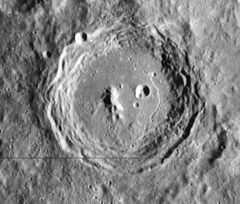Arzachel (crater)
|
Mosaic of Lunar Orbiter 4 images | |
| Coordinates | 18°12′S 1°54′W / 18.2°S 1.9°WCoordinates: 18°12′S 1°54′W / 18.2°S 1.9°W |
|---|---|
| Diameter | 96 km |
| Depth | 3.6 km |
| Colongitude | 3° at sunrise |
| Eponym | Abū Ishāq Ibrāhīm al-Zarqālī |


Arzachel is a relatively young lunar impact crater located in the highlands in the south-central part of the visible Moon, close to the zero meridian (the visible center of the Moon). It lies to the south of the crater Alphonsus, and together with Ptolemaeus further north the three form a prominent line of craters to the east of Mare Nubium. The smaller Alpetragius lies to the northwest, and Thebit is to the southwest along the edge of the mare.
Description
Arzachel is remarkably clear in its structure and a favorite telescope viewing subject for advanced amateur astronomers. The rim of Arzachel shows little sign of wear and has a detailed terrace structure on the interior, especially on the slightly higher eastern rim. There is a rough outer rampart that joins a ridge running from the north rim to southern rim of Alphonsus.
The rugged central peak of Arzachel is prominent, rising 1.5 kilometers above the floor, and is somewhat offset to the west with a bowed curve from south to north-northeast. The floor is relatively flat, except for some irregularities in the southwestern quadrant of the crater. There is a rille system named the Rimae Arzachel that runs from the northern wall to the southeast rim. A small crater lies prominently in the floor to the east of the central peak, with a pair of smaller craterlets located nearby.
Names
Arzachel is a Latinization of the name of the Arab astronomer and mathematician Abū Ishāq Ibrāhīm al-Zarqālī. Like many of the craters on the Moon's near side, Arzachel was named by Giovanni Riccioli, whose 1651 nomenclature system has become standardized.[1] Earlier lunar cartographers had given the feature different names: Michael van Langren's 1645 map calls it "Annae, Reg. Fran.", after Anne, the Regent of France,[2] and Johannes Hevelius called it "Mons Cragus" after one of the Mount Craguses of the ancient world.[3]
Satellite craters
By convention these features are identified on lunar maps by placing the letter on the side of the crater midpoint that is closest to Arzachel.
| Arzachel | Latitude | Longitude | Diameter |
|---|---|---|---|
| A | 18.0° S | 1.5° W | 10 km |
| B | 17.0° S | 2.9° W | 8 km |
| C | 17.4° S | 3.7° W | 6 km |
| D | 20.2° S | 2.1° W | 8 km |
| H | 18.7° S | 2.0° W | 5 km |
| K | 18.3° S | 1.6° W | 4 km |
| L | 20.0° S | 0.1° E | 8 km |
| M | 20.6° S | 0.9° W | 3 km |
| N | 20.4° S | 2.2° W | 3 km |
| T | 17.7° S | 1.3° W | 3 km |
| Y | 18.2° S | 4.3° W | 4 km |
References
- Wood, Chuck (2006-07-17). "Another FFC". Lunar Photo of the Day. Retrieved 2006-07-17.
- Andersson, L. E.; Whitaker, E. A. (1982). NASA Catalogue of Lunar Nomenclature. NASA RP-1097.
- Blue, Jennifer (July 25, 2007). "Gazetteer of Planetary Nomenclature". USGS. Retrieved 2007-08-05.
- Bussey, B.; Spudis, P. (2004). The Clementine Atlas of the Moon. New York: Cambridge University Press. ISBN 978-0-521-81528-4.
- Cocks, Elijah E.; Cocks, Josiah C. (1995). Who's Who on the Moon: A Biographical Dictionary of Lunar Nomenclature. Tudor Publishers. ISBN 978-0-936389-27-1.
- McDowell, Jonathan (July 15, 2007). "Lunar Nomenclature". Jonathan's Space Report. Retrieved 2007-10-24.
- Menzel, D. H.; Minnaert, M.; Levin, B.; Dollfus, A.; Bell, B. (1971). "Report on Lunar Nomenclature by the Working Group of Commission 17 of the IAU". Space Science Reviews 12 (2): 136–186. Bibcode:1971SSRv...12..136M. doi:10.1007/BF00171763.
- Moore, Patrick (2001). On the Moon. Sterling Publishing Co. ISBN 978-0-304-35469-6.
- Price, Fred W. (1988). The Moon Observer's Handbook. Cambridge University Press. ISBN 978-0-521-33500-3.
- Rükl, Antonín (1990). Atlas of the Moon. Kalmbach Books. ISBN 978-0-913135-17-4.
- Webb, Rev. T. W. (1962). Celestial Objects for Common Telescopes (6th revised ed.). Dover. ISBN 978-0-486-20917-3.
- Whitaker, Ewen A. (1999). Mapping and Naming the Moon. Cambridge University Press. ISBN 978-0-521-62248-6.
- Wlasuk, Peter T. (2000). Observing the Moon. Springer. ISBN 978-1-85233-193-1.
